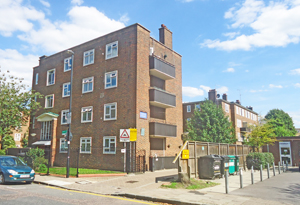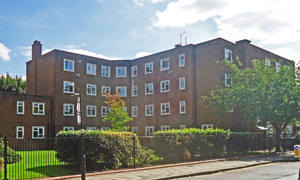|
Tylers and Bricklayers Almshouses King Henry's Walk, Balls Pond Road, Kingsland, N1 4NT
|
In 1832 the Tylers and Bricklayers Company raised a subscription in order to acquire funds to build almshouses for its poor liverymen and their widows.
In the following year an acre of land north of the Balls Pond Road, in the hamlet of Kingsland, was purchased for £300. Kingsland at this time was occupied with brickfields, nurseries and market gardens. It was regarded as a healthy and pleasant rural environment for the pensioners. (In fact, more almshouses were built in the area soon afterwards - the Metropolitan Benevolent Societies Almshouses in 1836, the Dyers Almshouses in 1841, the Bookbinders Almshouses in 1843 and the Cutlers Almshouses in 1850.)
The design for the eight almshouses - in a Gothic Revival style - was accepted in May 1834, and building work began.
The almshouses were completed at the end of 1835 and ready for occupation by Christmas. They consisted of one block with a shared roof. The central section, of two rooms, had a cupola mounted above its gable. The block had cost £1,545 to build, including the price of enclosing and draining the site, and sinking a well. They had a frontage on King Henry's Walk, a lane which led off Balls Pond Road and which was reputed to have been a favourite walk of King Henry VIII when staying at Newington Green for the hunt.
The first residents - one liveryman and seven widows - were chosen in March 1836. Each resident would have a large room with a stove and a bedstead, and a separate wash house.
The Company was responsible for repairs to the building and also provided each almsperson with a pension of £10 a year and one ton of coal.
During 1838-1839 two wings, with four almshouses each, were added to the north of the original buildings. The almshouse blocks surrounded a quadrangular spacious lawn on three sides. An entrance lodge was also built, with rooms for an attendant and his family. The arms of the Company were surmounted on its gable, with the motto "In God is all our trust".
Later, freemen and their widows also became eligible for admission to the almshouses.
In 1866 the land in front of the almshouses was leased for housing to be built along King Henry's Walk. The ground rent provided the Company with an annual income of £40, which was used for the benefit of the occupants of the almshouses. By the end of the 19th century, pension allowances had increased: a liveryman received an annual pension of £25 (£23 for a widow), and a freeman £20 (£18 for a widow). In addition, each almsperson received an amount of coal, not exceeding 3 tons.
By the mid 1920s the almshouses were deemed no longer suitable. Ten years later the site was sold to the Jewish Board of Guardians and Trustees for the Relief of the Jewish Poor. The almshouses closed in 1937.
Current status
The almshouses were demolished, either before or after WW2 (1939-1945). In March 1952 Islington Council bought the site - and also that of the neighbouring Dyers Almshouses - to build Tudor Court, a complex of apartment blocks.N.B. Photographs obtained in August 2017


The northwest aspect of Tudor Court.
References (Accessed 21st September 2020)
Lewis S 1842 The History of Topography of the Parish of Saint Mary, Islongton, in the County of Middlesex. London, J.H. Jackson.
https://aim25.com
https://collage.cityoflondon.gov.uk
https://en.wikipedia.org
www.architecture.com
www.british-history.ac.uk
www.islington.gov.uk
www.pensionsarchive.org.uk
www.tylersandbricklayers.co.uk
www.victorianlondon.org
Last updated 28th September 2020
Click here to return to Almshouses of London alphabetical list
Click here to return to home page